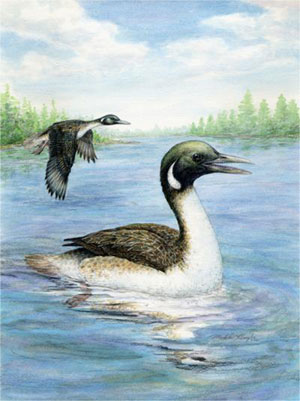 By LEE BOWMAN Scripps Howard News Service June 21, 2006
Details of five fossil specimens of the ancient birds, published Friday in the journal Science, are helping to fill in the avian family tree and suggest that modern birds may have gotten their start in watery environments. Scientists led by Hai-lu You of the Chinese Academy of Geological Science in 2004 recovered the samples from mudstone deposited in an ancient lake. The sediment captured and neatly preserved the impressions of bones in three dimensions, and even preserved the outlines of feathers and webbed feet. Previously, no more than a fossilized foot of one of the birds had been recorded. However, none of the remains included a skull. "Soft tissues cannot be preserved normally, but a lake environment, compared to a river, is kind of quiet," You told a news conference in Washington on Thursday. "Extremely fine sediment can be deposited yearly and soft parts can be preserved." The bird - called "Gansus yumenensis," after the region and town near where the remains were found - "is very close to a modern bird and helps fill in the big gap between clearly non-modern birds and the explosion of early birds that marked the Cretaceous period, the final era of the Dinosaur Age," said Peter Dodson, a professor of anatomy and earth and environmental sciences at the University of Pennsylvania. You was a doctoral student under Dodson, the study's co-author, at Penn in the 1990s. Although headless, the remains provide ample evidence of an upper body and wing structure that allowed amphibian takeoffs, and webbed feet and bony knees indicating that the birds swam. "Webbed feet is an adaptation that has evolved repeatedly in widely separate groups of animals, such as sea turtles, whales and manatees, and would only hinder climbing or landing in trees," said Jerald Harris, director of paleontology at Dixie State College of Utah and another member of the study team. "It appears that the early ancestors of modern birds lived lifestyles that today we would stereotype as being ducklike, heronlike, loonlike, etc," Harris said. "Gansus likely behaved much like its modern relatives, probably eating fish, insects and the occasional plant, although we won't have a definitive dietary answer until we find a skull." Gansus belongs to a lineage of birds called the Ornithurae, which includes all modern birds as well as their immediate fossil ancestors. It's the oldest specimen yet found for the group, which scientists think arose between 140 million and 110 million years ago. Finding such an advanced bird in China from so long ago is surprising because large numbers of more primitive "feathered dinosaur fossils" dating only 10 million years or so older than the more modern examples have been found over the past decade in Liaoning Province, northeast of Beijing. Those birds had joints reversed in motion from those of modern birds, but also don't seem to have had webbed feet or anything else that would have given them an advantage on the water. Like all the dinosaurs, the feathered dinos disappeared at the end of the Cretaceous 65 million years ago - but the modern birds, including some that regained the claws needed for life in trees, survived and thrived. Although it seems that aquatic-oriented birds were more common in the early Cretaceous, other remains indicate that modern terrestrial bird groups such as the ostrich and chicken family have roots going back 80 million to 90 million years.
On the Net:
Distributed to subscribers for publication by Scripps Howard News Service, http://www.shns.com Publish A Letter on SitNews Read Letters/Opinions
|
||
